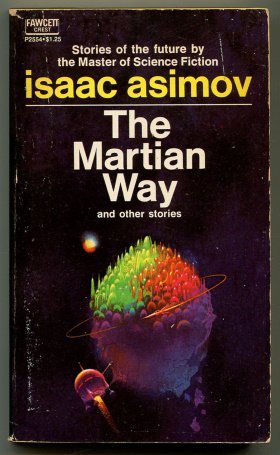‘It must have happened before,’ said Finley. ‘The legends of such Geese must have started somehow.’
‘Do you want to wait?’ asked Billings.
If we had a gaggle of such Geese, we could begin taking a few apart. We could study its ovaries. We could prepare tissue slices and tissue homogenates.
That might not do any good. The tissue of a liver biopsy did not react with oxygen-18 under any conditions we tried.
But then we might perfuse an intact liver. We might study intact embryos, watch for one to develop the mechanism.
But with only one Goose, we could do none of that.
We don’t dare kill The Goose That Lays The Golden Eggs. The secret was in the liver of that fat Goose.
Liver of fat goose! Pate de Joie gras! No delicacy to us!
Nevis said thoughtfully, ‘We need an idea. Some radical departure. Some crucial thought.’ ,
‘Saying it won’t bring it,’ said Billings despondently.
And in a miserable attempt at a joke, I said, ‘We could advertise in the newspapers,’ and that gave me an idea.
‘Science fiction!’ I said. ‘What?’ said Finley.
‘Look, science-fiction magazines print gag articles. The readers consider it fun. They’re interested.’ I told them about the thiotimoline articles Asimov wrote and which I had once read.
The atmosphere was cold with disapproval.
‘We won’t even be breaking security regulations,’ I said, ‘because no one will believe it.’ I told them about the time in 1944 when Cleve Cartmill wrote a story describing the atom bomb one year early and the F.B.I. kept its temper.
‘And science-fiction readers have ideas. Don’t underrate them. Even if they think it’s a gag article, they’ll send their notions in to the editor. And since we have no ideas of our own, since we’re up a dead-end street, what can we lose?’
They still didn’t buy it.
So I said, ‘And you know . . . The Goose won’t live forever.’ That did it, somehow.
We had to convince Washington; then I got in touch with John Campbell, editor of the magazine, and he got in touch with Asimov.
Now the article is done. I’ve read it, I approve, and I urge you all not to believe it. Please don’t.
Only—
Any ideas?
Galley Slave
The United States Robot and Mechanical Men, Inc., as defendants in he case, had influence enough to force a closed-doors trial without a jury.
Nor did Northeastern University try hard to prevent it. The trustees ew per!ectly well how the public might react to any issue involving m1sbehav1or of a robot, however rarefied that misbehavior might be. They also had cl arly vi ualized notion of how an anti-robot riot might become an ant1-sc1ence not without warning.
The government, as represented in this case by Justice Harlow Shane was equally anxious for a quiet end to this mess. Both U.S. Robots and the ac demic world were bad people to antagonize.
Justice Shane said, ‘Since neither press, public nor jury is present, gentlemen, let us stand on as little ceremony as we can and get to the facts.’
He smiled stiffly as he said this, perhaps without much hope that his request would be eff ctive, and hitched at his robe so that he might sit more omfortably. His face was pleasantly rubicund, his chin round and soft, his nose broad and his eyes light in color and wide-set. All in all it was not a face with much judicial majesty and the judge knew it. ‘
Barnabas H. Goodfellow, Professor of Physics at Northeastern U., was sworn in first, taking the usual vow with an expression that made mincemeat of his name.
After the usual opening-gambit questions, Prosecution shoved his hands deep into his pockets and said, ‘When was it, Professor, that the matter of the possible employ of Robot EZ-27 was first brought to your attention, and how?’
Professor Goodfellow’s small and angular face set itself into an uneasy expression, scarcely more benevolent than the one it replaced. He said, ‘I have had professional contact and some social acquaintance with Dr Alfred Lanning, Director of Research at U.S. Robots. I was inclined to listen with some tolerance then when I received a rather strange suggestion from him on the 3rd of March of last year—’
‘Of 2033?’
‘That’s right.’
‘Excuse me for interrupting. Please proceed.’
The professor nodded frostily, scowled to fix the facts in his mind, and began to speak.
Professor Goodfellow looked at the robot with a certain uneasiness. It had been carried into the basement supply room in a crate, in accordance with the regulations governing the shipment of robots from place to place on the Earth’s surface.
He knew it was coming; it wasn’t that he was unprepared. From the moment of Dr Lanning’s first phone call on March 3, he had felt himself giving way to the other’s persuasiveness, and now, as an inevitable result, he found himself face to face with a robot.
It looked uncommonly large as it stood within arm’s reach.
Alfred Lanning cast a hard glance of his own at the robot, as though making certain it had not been damaged in transit. Then he turned his ferocious eyebrows and his mane of white hair in the professor’s direction.
‘This is Robot EZ-27, first of its model to be available for public use.’ He turned to the robot. ‘This is Professor Goodfellow, Easy.’

























